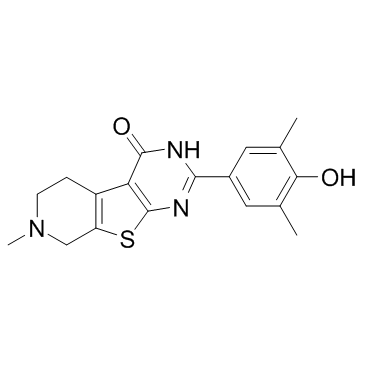| Description |
FL-411 is a potent and selective BRD4 inhibitor with an IC50 of 0.43±0.09 μM for BRD4(1).
|
| Related Catalog |
|
| Target |
BRD4(1):0.43 μM (IC50)
|
| In Vitro |
FL-411 is a selective BRD4 inhibitor. Binding affinities of FL-411 are measured by TR-FRET against the first and second bromodomains of BRD2(1), BRD4(1), and BRD4(2) with IC50s of 24.60±0.70 μM, 0.47±0.02 μM, 0.93±0.05 μM, respectively. FL-411 possesses a good BRD4(1) inhibition activity (IC50=0.43±0.09 μM), antiproliferative activity (MCF-7, IC50=1.62±0.06 μM; MDA-MB-231, IC50=3.27±0.14 μM), and autophagic activity (42.29% in MCF-7 cells), as well as displays a low toxicity against MCF10A cells). FL-411 induces ATG5-dependent autophagy-associated cell death (ACD) by blocking BRD4-AMPK interaction and thus activating AMPK-mTOR-ULK1-modulated autophagic pathway in breast cancer cells[1].
|
| In Vivo |
To evaluate the antitumor activity of FL-411 in vivo, two breast tumor xenograft models, namely, MCF-7 and MDA-MB-231 cell lines models, are used. The in vivo study is conducted using three different doses of FL-411: 25 mg/kg, 50 mg/kg, and 100 mg/kg. In all the models, FL-411 shows significant tumor growth inhibition in a dose-dependent manner as determined by 80% and 76% tumor growth inhibition ratio in MCF-7 and MDA-MB-231 cell models, respectively. A remarkable loss of tumor weights is observed in all dose groups (p<0.001). FL-411 displays no obvious effects on the body weight of all the treatment groups. To examine whether FL-411-mediated inhibition of tumor growth in vivo is associated with reduced cell proliferation and the increased autophagy-associated cell death, tumor tissues from control and FL-411-treated mice are processed for the immunohistochemical analysis of Ki-67 and LC3. FL-411 treatment obviously reduces the number of Ki-67 (p<0.001) positive cells as well as increases autophagy levels, which is determined by increased LC3 expression (p<0.001)[1].
|
| Cell Assay |
The MCF-7 and MDA-MB-231 cells are dispensed in 96-well flat bottom microtiter plates at a density of 5×104 cells/mL. After 24 h incubation, MCF-7 or MDA-MB-231 cells are treated with 1.5 and 3 μM FL-411, respectively. 3-MA (1 mM) is added 1 h before treated with FL-411. After treatment, cell viability is measured by the MTT assay. 5 mg/mL MTT is added to each well. After 4 h incubation, the medium is removed and 150 μL of DMSO is added to each well to dissolve the crystal formazan dye. Absorbance is measured at 570 nm on an enzyme-linked immunosorbent assay reader[1].
|
| Animal Admin |
Mice[1] 52 female nude mice (BALB/c, 6-8 weeks, 20-22 g) are injected subcutaneously with MCF-7 cells or MDA-MB-231 cells (5×106 cells/mouse), respectively. When the tumors reach 100 mm3 in volume, the mice are divided into four groups for each cell line. Three groups are treated with different doses of FL-411 (low dose, 25 mg/kg; median dose, 50 mg/kg; high dose, 100 mg/kg) once a day by intragastric administration for 24 or 27 days, whereas the control group is treated with vehicle control. During the treatment, the tumor volumes and body weight are measured every 3 days until the end of the study. At the end of treatment, all mice are sacrificed. The tumor tissues are harvested, weighed, and photographed. Then, the tumor tissues are frozen in liquid nitrogen or fixed in formalin immediately[1].
|
| References |
[1]. Ouyang L, et al. Discovery of a Small-Molecule Bromodomain-Containing Protein 4 (BRD4) Inhibitor That InducesAMP-Activated Protein Kinase-Modulated Autophagy-Associated Cell Death in Breast Cancer. J Med Chem. 2017 Dec 28;60(24):9990-10012.
|
